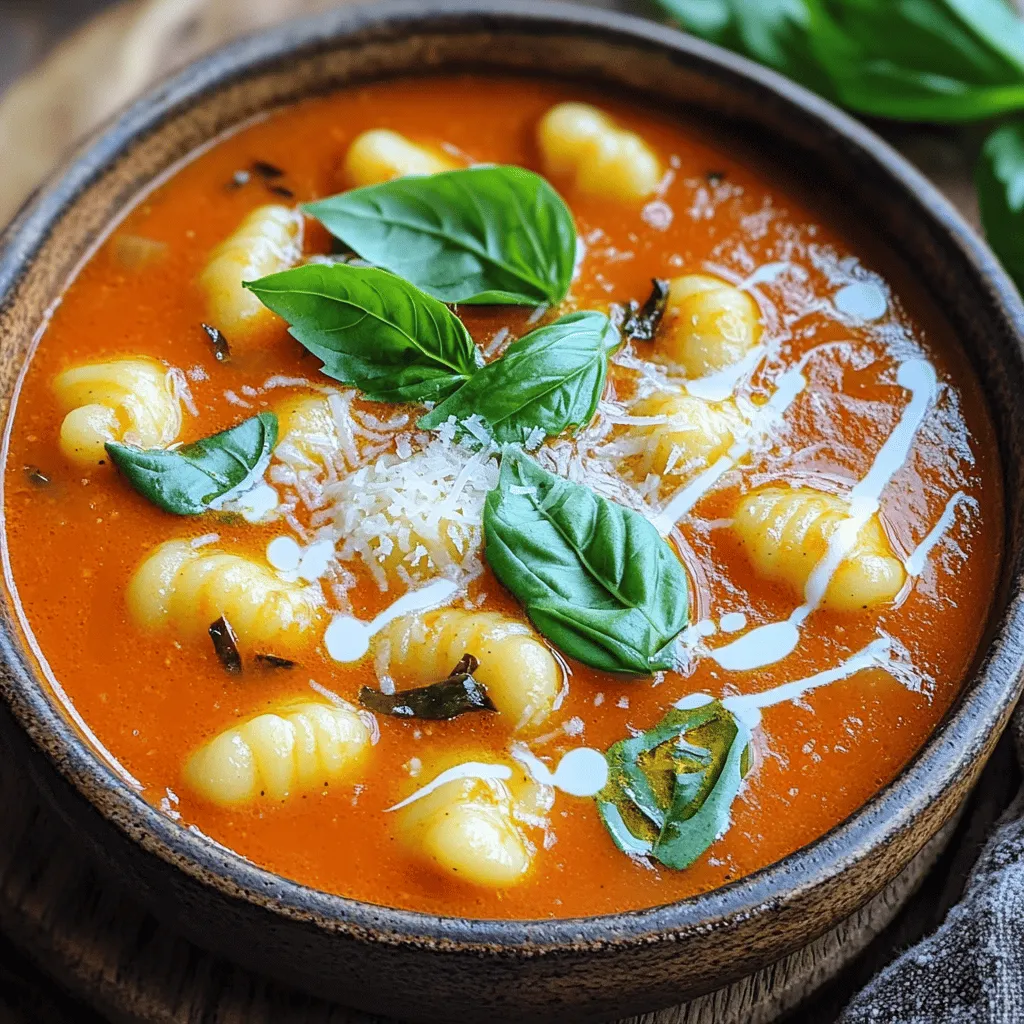When comfort food calls, nothing beats a bowl of Creamy Tomato Basil Gnocchi Soup. This easy dish blends rich flavors with tender gnocchi, making it perfect for any day. I’ll guide you through simple steps to create this heartwarming soup. Whether you’re a kitchen rookie or a seasoned chef, you’ll find joy in every spoonful. Ready to cook up some magic? Let’s dive in!
Ingredients
List of Ingredients
– Olive oil
– Onion
– Garlic
– Diced tomatoes
– Vegetable broth
– Dried oregano
– Sugar
– Potato gnocchi
– Heavy cream or coconut cream
– Fresh basil leaves
– Salt and pepper
– Grated Parmesan cheese (optional)
This creamy tomato basil gnocchi soup needs simple, fresh ingredients. First, gather one tablespoon of olive oil. This will help sauté your onion to start the base. Next, you need one medium onion. Dice it finely for even cooking.
You will also want three cloves of garlic. Minced garlic adds great flavor. Use two cups of diced tomatoes, either canned or fresh. The tomatoes create a rich, tasty base.
For the soup, four cups of vegetable broth are essential. This adds depth and helps blend the flavors well. One teaspoon of dried oregano adds a nice herbal note. You’ll also want one teaspoon of sugar to balance the tomato’s acidity.
The star of the dish is 250 grams of potato gnocchi. This is what makes the soup hearty. To make it creamy, use one cup of heavy cream or coconut cream for a dairy-free option.
For freshness, you’ll need one cup of chopped fresh basil leaves. Lastly, add salt and freshly cracked pepper to taste. If you like, you can sprinkle grated Parmesan cheese on top before serving. These ingredients come together to create a warm, comforting dish.
Step-by-Step Instructions
Preparation of the Base
To start our creamy tomato basil gnocchi soup, heat 1 tablespoon of olive oil in a large pot over medium heat. Once the oil is hot, add 1 medium onion, diced. Sauté the onion for about 5 minutes. You want it to turn translucent. This step builds a nice base flavor for the soup.
Next, add 3 cloves of minced garlic. Cook it for 1-2 minutes while stirring. This helps the garlic release its great aroma without burning.
Creating the Soup Base
Now, it’s time to add some key ingredients. Pour in 2 cups of diced tomatoes, either canned or fresh. Then, add 4 cups of vegetable broth. Stir in 1 teaspoon of dried oregano and 1 teaspoon of sugar. The sugar helps balance the acidity of the tomatoes. Mix it well and bring the pot to a gentle simmer. Let it cook for about 10 minutes. This allows the flavors to meld beautifully.
Blending the Soup
After simmering, it’s blending time! If you have an immersion blender, use it to blend the soup until smooth. If not, carefully transfer the soup to a standard blender in batches. Blend until smooth, then return it to the pot. This step makes the soup creamy and velvety.
Cooking the Gnocchi
Now, add 250 grams of potato gnocchi to the simmering soup. Cook the gnocchi for 3-5 minutes. You’ll know they are ready when they float to the surface. This means they are cooked through and ready to enjoy.
Finishing Touches
Lower the heat and gently stir in 1 cup of heavy cream, or coconut cream for a dairy-free version. Make sure to heat it through without boiling. This keeps the soup rich and creamy. Finally, add 1 cup of chopped fresh basil leaves. Season the soup with salt and freshly cracked pepper to taste. Stir well to mix in all the flavors.
Tips & Tricks
Best Practices for Sautéing
To start off, you want to avoid burnt garlic. Garlic burns fast. Add it to the pot after the onion has cooked for a few minutes. This way, the onion softens before the garlic hits the heat. When you do add garlic, stir it often. This helps keep it from burning.
Next, let’s focus on achieving a perfect onion texture. Cook the diced onion over medium heat. Stir often until the onion turns translucent. This should take about five minutes. This soft texture adds a great base flavor for your soup.
Blending Techniques
Now, let’s talk about blending techniques for a smooth consistency. If you use an immersion blender, pulse slowly at first. This prevents splashing. Blend until the soup is creamy and smooth. If you use a standard blender, wait for the soup to cool a bit before blending. Hot soup can splatter and burn.
When blending hot liquids, safety is key. Always fill the blender halfway. Leave room for steam to escape. Use a towel to cover the lid. This way, you keep everything safe and clean.
Cream Alternatives
If you’re looking for cream alternatives, consider using coconut cream. It gives a rich taste without dairy. Just swap it with heavy cream in the recipe. This change keeps your soup creamy and tasty.
Also, adjust for dietary restrictions. If someone is dairy-free, coconut cream is a great choice. You can also use almond or cashew cream. These options keep the soup delicious for everyone.

Variations
Adding Protein
You can add chicken or sausage to your soup for a hearty meal. Cook the meat first, then add it to the soup after blending. This will give your dish a nice, savory boost. For a vegetarian-friendly option, try adding beans or lentils. They provide protein and make the soup filling.
Making it Spicier
If you like heat, add red pepper flakes. Start with a pinch and adjust to your taste. You can also use spicy diced tomatoes for an extra kick. This simple change will turn your comforting soup into a warm, zesty delight.
Alternative Herbs
While basil is classic, you can switch it up with other herbs. Try using parsley or oregano for different flavors. Mixing in thyme can also add depth. Don’t be afraid to explore these combinations. Each herb brings its own unique taste, making your soup exciting and new!
Storage Info
Storing Leftovers
To keep your soup fresh, store it in the fridge. Use an airtight container for best results. The soup lasts about three days. If you want to save it for longer, freeze it. Use freezer-safe bags or containers. This way, it can last up to three months.
Reheating Instructions
You can reheat your soup in two ways: the microwave or stovetop. For the microwave, place the soup in a bowl. Heat it for 1-2 minutes, stirring halfway. For the stovetop, pour the soup into a pot. Warm it over low heat, stirring often to avoid sticking.
How to Maintain Creaminess
When reheating cream-based soups, keep the heat low. High heat can cause separation. Stir in a splash of cream as you reheat. This helps keep that rich, creamy texture. If the soup seems thick, add a little broth or water. This restores the perfect consistency.
FAQs
Can I make Creamy Tomato Basil Gnocchi Soup dairy-free?
Yes, you can make this soup dairy-free! Instead of heavy cream, use coconut cream. It adds a rich taste while keeping it plant-based. You can also try almond milk or cashew cream for a lighter option. Both choices work well and keep the soup creamy.
How long can I store the soup in the fridge?
You can store the soup in the fridge for up to 3 days. Make sure to keep it in an airtight container. If you want it to last longer, freeze it. Just remember, the gnocchi may change texture when reheated.
Can I use fresh gnocchi instead of store-bought?
Absolutely! Fresh gnocchi can make the soup taste even better. If you want to make your own, use a simple potato gnocchi recipe. Just remember to cook it for a few minutes longer than store-bought gnocchi. Fresh gnocchi adds a lovely, soft texture to the soup.
What can I serve with this soup?
This soup pairs well with crusty bread or a fresh salad. A warm baguette is perfect for dipping. You could also serve it with a simple side salad. The freshness of the salad balances the creamy soup nicely.
This blog post shared a simple recipe for creamy tomato basil gnocchi soup. We looked at each ingredient, from olive oil to Parmesan. I guided you through step-by-step instructions to create the soup. I offered tips for sautéing and blending. We also explored variations, from adding proteins to adjusting spices. Finally, I discussed storage tips and answered your common questions.
With these tools, you can enjoy a comforting, delicious bowl of soup any time. Happy cooking!


